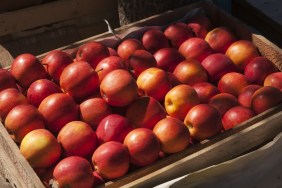It’s hard to believe that a few years ago, green juice was considered extreme. These days, between Juice Press, Juice Generation, Organic Avenue and countless other brands, you can barely walk a block in most major cities without being faced with a juice option. Unfortunately, green juices aren’t always as healthy as you might think. Here are a few things to consider next time you’re craving a kale and apple juice.
Your Juice Was Juiced Versus Blended
When you’re buying a green juice that was made via juicing, you are not getting much, if any, fiber as the process extracts only water and nutrients from the produce. Without said fiber, your digestive system doesn’t have to work as hard to break down the food and absorb the nutrients allowing everything to be absorbed into your bloodstream quickly, causing a rapid spike in blood sugar; this is why so many juice cleanses claim to give your digestive system a break. While this may be helpful if you’re having digestive issues, most people’s diets are severely lacking in fiber. Moreover, the fiber in produce not only provides a steady release of nutrients into the bloodstream, it also fills you up. Instead of juicing, most people would benefit from opting for blended juices, which consist of the entire fruit or vegetable, including the skin. Blending is not only less messy, more cost-effective and faster, but blended juices give you all the fiber while being easier to digest than eating fruits and vegetables whole as the fiber is broken apart in the blender.
You Wait Too Long Before Drinking Your Juice
The natural enzymes in fruits and vegetables start breaking down as soon as they are exposed to light and air.
You Aren’t Using the Right Equipment
Invest in a good blender (Vitamix or NutriBullet), as it’s important that your blender not heat up the enzymes in your fruits and vegetables as it’s pulling apart the fibers.
Your Juice is Thickened with Soy or Dairy
Many juices are thickened with milk, soy, yogurt and ice cream — avoid these as they will not only add in calories and fat, but can actually be bad for your health.
Your Juice Has a Fruit Juice Base
Most fruit juices are sweetened with sugar, adding calories without fiber. If you want to add some sweetness to your green juice, opt for a whole green apple or coconut water if you’re looking for some “filler.”
Your Juice Has Too Many Sweet Fruits and Not Enough Green Vegetables
A green juice, as the name suggests, should be mostly greens. While apples, pears, bananas, etc. are great, they are high in sugar and calories.
You’re Adding Green Juice to Your Diet But Not Taking Anything Out
While it may be true that not all calories are created equal (i.e. your body will respond better to 200 calories of broccoli than it will to 200 calories of gummy bears), if you’re looking to lose weight, adding juice to your diet without taking anything out will only result in weight gain.
You’re Having Too Much of a Good Thing
Don’t always opt for kale or spinach. Mix up your greens with turnips, collards, chard, beet greens, dandelion greens, romaine lettuce, cabbage, etc. to avoid a potential overdose on certain nutrients (this is especially important if you have a medical condition that may be exacerbated by compounds found in certain leafy greens, so speak with your doctor).








